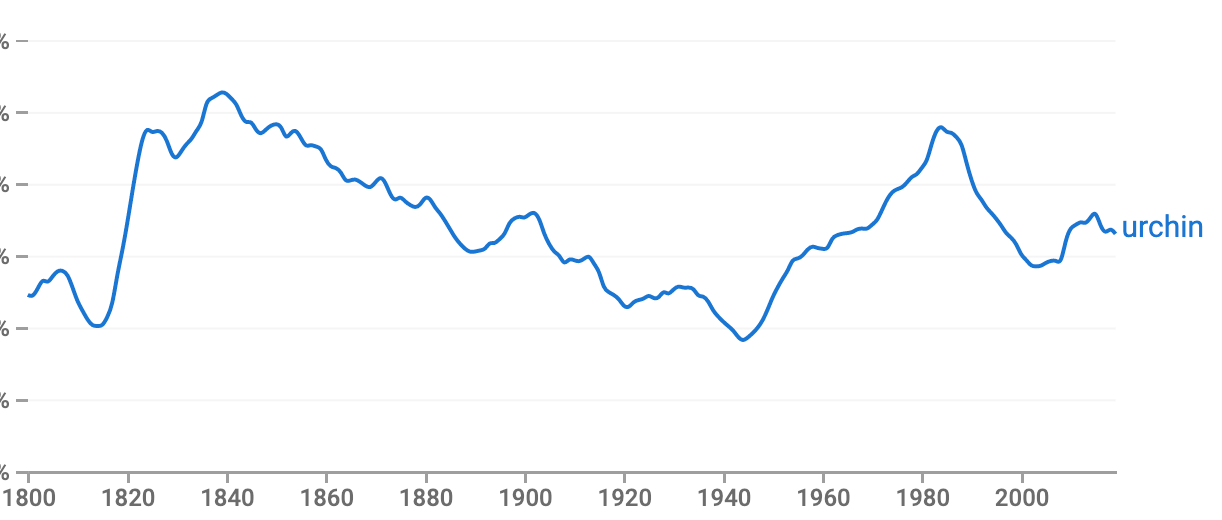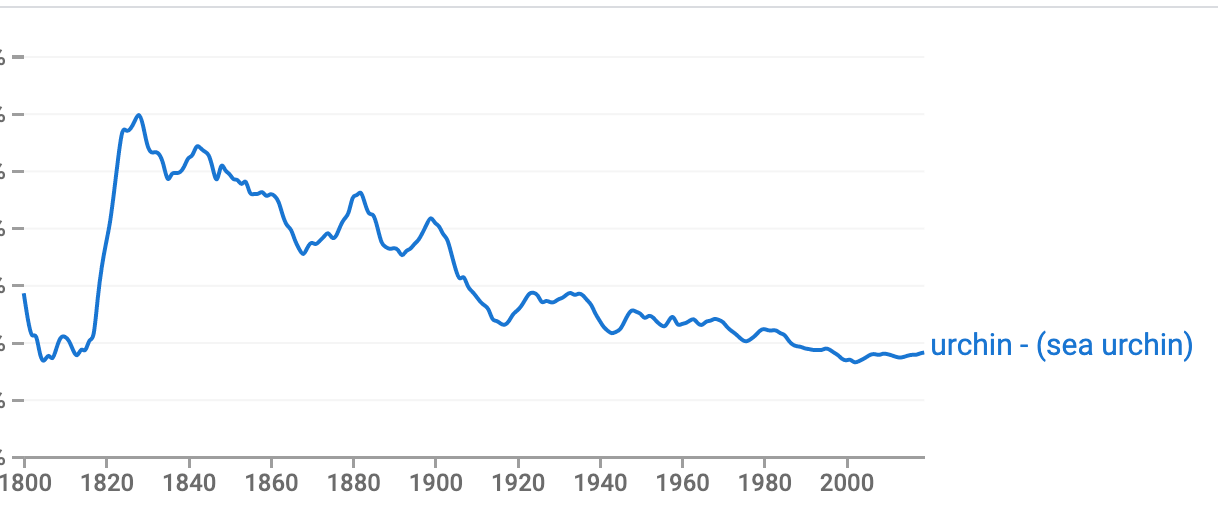Pibe → urchin?
« previous post | next post »
David Lobina writes:
In the context of Diego Maradona's recent passing, I have been struck by how often he's been referred to as a 'street urchin' in the British press in the last 24 hours or so, and not only because the term sounds rather old-fashioned to me. One (nice) article from The Guardian is rather representative, as the author quotes a 1928 article from an Argentinian periodical on the footballing skills of Buenos Aires street children that uses the word 'pibe' to refer to these children, a word that usually refers to young people in general (at least according to the DRAE). In fact, I would say the reader understands that the author is talking about street children because of the context rather than from any particular word.
Anyway, what I find most curious about this is that the Guardian article glosses the word 'pibe' as 'urchin', which is not entirely correct, and many other newspapers in the UK seem to have run with this epithet for Maradona.
Wiktionary agrees that pibe is a general (Buenos Aires area) term for "Persona que se encuentra en la adolescencia o juventud", and the Wikipedia article confirms this.
As for urchin, the OED tells us that it began as a term for hedgehogs (and by extension, sea urchins), and then came to be used for "A pert, mischievous, or roguish youngster; a brat", and then ("in frequent use from c1780") "Often applied with commiserative force to children poorly, raggedly, or untidily clothed." I share David Lobina's impression that urchin seems a bit old-fashioned, but Google Books ngrams doesn't really support us:
Some of the "Maradona as urchin" examples:
[link] This sense of freedom was only deepened by Maradona’s own impoverished background, and how he was often somewhat disparagingly described as the urchin who rose out of the Buenos Aires slum. This was almost literal, given the story about how he fell into a cesspit as a toddler following a ball.
[link] Both goals against England epitomised man and legend. The first showed Maradona the urchin born of Buenos Aires not only cheating but getting away with it — an Argentine artful dodger.
[link] Diego Maradona dead at 60: From street urchin to the greatest footballer in the world
[link] Perhaps his story begins in 1928, when Borocoto, the editor of El Grafico, wrote his famous editorial outlining what a statue that depicted the soul of the Argentinian game would look like. It would be, he wrote: “A pibe [urchin] with a dirty face, a mane of hair rebelling against the comb; with intelligent, roving, trickster and persuasive eyes and a sparkling gaze that seem to hint at a picaresque laugh that does not quite manage to form on his mouth, full of small teeth that might be worn down through eating yesterday’s bread."
The NYT obituary quotes the same 1928 passage, but translates "pibe" as "street kid":
Thirty-two years before Maradona was born, the writer Borocotó — editor of El Gráfico, the prestigious, trailblazing sports magazine — suggested the country should erect a statue to the so-called pibe: the dusty-faced street kid with the “trickster eyes,” “a mane of hair rebelling against the comb” and the “sparkling gaze” who represented not only Argentina’s soccer culture, but also its self-image as a nation.
That passage links "pibe" to a 2014 article by Segio Levinsky, "The Cult of the Pibe: Argentina's ongoing love affair with scruffy urchins with feet of gold", The Blizzard 3/1/2014. That article in turn cites a 1943 tango "El sueño del pibe", which expresses the dreams of an apparently less impoverished youth, and was sung (with a few modernizing changes) by Maradona himself:

Laura Morland said,
November 26, 2020 @ 10:20 am
It's interesting that "urchin" is more in use than perhaps any of us would have thought.
I was curious how the French would translate "pibe". Le Monde chose the word "gosse," which does not have the dusty feel of "urchin":
La mort d’un champion est toujours un événement triste. Celle du « Pibe de Oro » (« le gosse en or »), comme l’Argentine continuait de l’appeler, réveillera de profonds antagonismes chez les amateurs de ballon rond. Peu de sportifs auront, comme lui, alimenté avec autant de zèle les deux foyers contraires du supporteurisme que sont l’adulation et la détestation. L’auteur de la « main de Dieu », le protégé de la mafia napolitaine, l’ami de Fidel Castro et d’Hugo Chavez, le cocaïnomane incurable ne fut pas un enfant de chœur ni un modèle de vertu, loin de là. Il restera néanmoins comme l’un des plus grands joueurs de l’histoire du football. Un génie du ballon à l’inspiration insolente.
https://www.lemonde.fr/disparitions/article/2020/11/25/diego-maradona-le-dieu-du-ballon-rond-est-mort_6061111_3382.html
F said,
November 26, 2020 @ 11:35 am
Don't you think the vast majority of these recent "urchins" are sea urchins, even when not specified that way?
Murray Smith said,
November 26, 2020 @ 12:22 pm
@F: Your idea is confirmed by Google’s Ngram Viewer, searching for “urchin, sea urchin”.
[(myl) Indeed —

]
Adam Rosen said,
November 26, 2020 @ 12:43 pm
Not for nothing, when I lived in Argentina, from 2005 to 2006, one of the most popular cumbia villera bands in the country was Los Pibes Chorros ("the thieving kids"). To the unfamiliar, cumbia villera is an explicit "street" take on cumbia, the popular Latin American folk music ("villera" being an adjective derived from "villa," the term for slum in Argentina). It's strongly associated with the lower class, and by some with juvenile delinquency, and functioned as a sort of Argentine hip-hop in that it depicted life on the margins (despite the fact that there was, and maybe still is, a thriving hip-hop scene in Argentina).
My sense is that given the content of Pibes Chorros songs (drugs, sex, violence, youthful nihilism, the like), the use of "pibe" in the band's name was intended to signal an outcast, delinquent, or tough guy . . . maybe even an urchin. On the other hand, Lionel Messi, the FC Barcelona wunderkind and pride of Argentina, was simply referred to as "El Pibe" despite having a middle-class background. So I think the term can have varied connotations.
David L. Gold said,
November 26, 2020 @ 2:13 pm
All the explanations in the newspapers (except that of Le Monde) and in earlier comments about why Maradona came to be called el pibe are wrong.
Pibe, besides all the definitions and translations given there, is also an affectionate way of referring to a child. In that sense, it has an exact English equivalent, namely kid. It is frequent in Argentine Spanish to call one's child el pibe (if a male) or la piba (if a female) or one's children los pibes or las pibas.
Furthermore, as a nickname, it can survive into the bearer's adulthood, just as "the kid" did in Billy the Kid.
The Dictionary of the Royal Spanish Academy (referred to in the newspaper article by its abbreviated name, DRAE) correctly defines the word as:
1. m. y f. coloq. Arg., Bol. y Ur. Niño o joven. En Esp., u. c. jerg.
2. m. y f. coloq. Arg. y Bol. U. como fórmula de tratamiento afectuosa.
Notice the word afectuosa 'affectionate' in definition 2.
As applied to Maradona, the word therefore has nothing to do with street urchins, poor people, etc.
@ Laura Morland. Le Monde got it right: gosse is an exact French equivalent of Spanish pibe in its affectionate sense.
Bob Ladd said,
November 26, 2020 @ 5:40 pm
Now that David Gold has set the record straight on pibe, what about urchin? Does it still apply to hedgehogs anywhere in English? And what's the metaphor that gets it from hedgehog to street kid?
Also, Italian uses riccio (which basically means hedgehog) for sea urchins (riccio di mare) as well – are there other languages besides Italian and English that have undergone that same semantic extension? At least that metaphor is fairly transparent.
F said,
November 26, 2020 @ 9:09 pm
@Bob Ladd — the Russian word for sea urchin is straightforwardly "sea hedgehog" (морской ёж).
Rob K said,
November 27, 2020 @ 9:00 am
@Bob Ladd Spanish (erizo de mar) and Catalan (eriçó de mar) off the top of my head. In Polish it seems jeż morski is acceptable but jeżowiec is more common (so again from hedgehog, jeż, but I couldn't say for certain what -owiec is doing here). Likewise in French, hérisson de mer seems an alternative to the more common oursin. Interestingly, there's also apparently a dated synonym of châtaigne de mer (lit. sea chestnut).
Frank said,
November 27, 2020 @ 10:45 am
In German it is Seeigel.
According to what I can gather from Wikipedia, Igel is not a direct translation of hedgehog, but describes a superset of hedgehogs and other related animals. Still the same principle.
CuConnacht said,
November 27, 2020 @ 10:48 am
The French for sea urchin is oursin, from the same Latin root as hérisson = hedgehog. French Wikipedia tells me that sea urchins can be called hérissons de mer.
Bob Ladd said,
November 27, 2020 @ 12:25 pm
Thanks for all the answers about other languages – clearly a general European thing. Also, the French form oursin makes it obvious that French is the source of English urchin (confirmed by OED), but I'm still curious about when the English word stopped being used for hedgehogs, and about what metaphor gets us from hedgehog to "mischievous youngster, brat" (OED again).
Leo said,
November 27, 2020 @ 2:22 pm
I find it easier to imagine the UK press using "urchin" for somebody from faraway Argentina than for a British footballer, so there may be a touch of exoticism about it, even if not intended. In a British context, "urchin" brings to mind the world of Dickens. There are contemporary equivalents, such as "chav", but they are less generously interpretable.
Coby Lubliner said,
November 27, 2020 @ 5:52 pm
The Colombian player Carlos Valderrama was also called el pibe; according to Spanish Wikipedia, the nickname was given to him by an Argentine friend of his father's.
cameron said,
November 27, 2020 @ 6:33 pm
"Street hedgehog" is definitely a strange metaphor to use to describe a homeless child. Another term used by social reformer types from the late 19th and early 20th century is "street Arab". I guess the paradigmatic Arab, according to the popular imagination in the English speaking world at that time, was a nomadic bedouin.
cliff arroyo said,
November 27, 2020 @ 7:31 pm
I'm not sure of how it happened but in Polish hedgehog is jeż and sea urchin is jeżowiec (-owiec is a kind of derivational suffix added to nouns to make a similar noun that has a relation to the root as in sport – sportowiec (athlete).
Rodger C said,
December 1, 2020 @ 1:01 pm
I'd suppose that street children resemble(d) hedgehogs in their dirty, spiky hair.
V said,
December 3, 2020 @ 4:05 pm
cliff arroyo: The cognate to jeżowiec in Bulgarian — "язовец" means badger. As in https://en.wikipedia.org/wiki/European_badger
V said,
December 3, 2020 @ 4:53 pm
And you can imply something in the form of a hedgehog by saying something with "ѣж" at the root, but it would sound Polonic :)
George said,
December 4, 2020 @ 10:16 am
@Leo
I wouldn't see 'chav' as being in any way equivalent to 'urchin', not even in the sense you suggest of a particularly pejorative way of referring to the sort of person who would once have been referred to as an 'urchin'. There's no suggestion of homelessness in 'chav', there's certainly no suggestion of being dirty or dressed in rags (on the contrary, the image is more one of branded sportswear) and the age ranges covered by the terms, while they may overlap a bit, are very different. Maybe you're North American…?